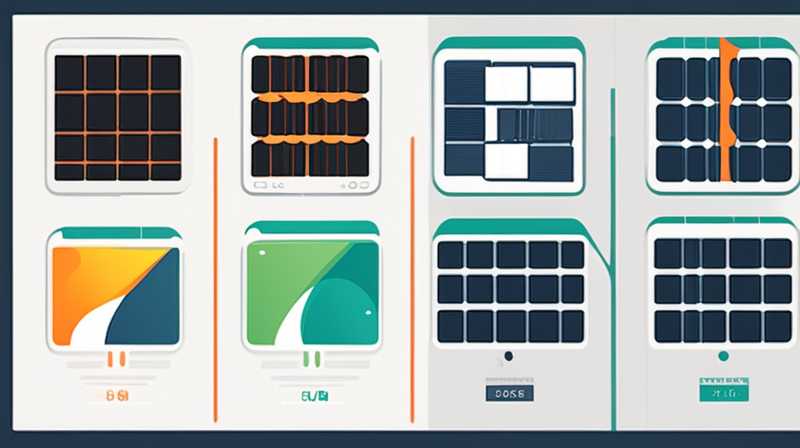
1. Directly assess the functionality of a solar panel by examining the following indicators: 1) visual inspection, 2) energy output comparisons, 3) multimeter testing, 4) inverter diagnostics. The most comprehensive way to ensure accurate evaluation is through energy output comparisons, where the energy produced is compared to expected production levels based on historical data, location, and panel specifications. This allows for detection of discrepancies that may suggest underlying issues such as malfunction or degradation.
1. VISUAL INSPECTION
The preliminary phase in determining the condition of a solar panel entails conducting a meticulous visual inspection. These panels are often exposed to diverse weather conditions, leading to potential physical degradation over time. Look for cracks, discoloration, or signs of impact damage. Such visible issues can be indicative of internal failures or reduced efficacy. For example, a hairline fracture on the surface may not seem severe but can lead to moisture ingress and further damage.
Apart from cracks, another factor to consider during this inspection is the presence of dirt, debris, and residue on the surface. Solar panels function optimally when they are clean, as dirt can obstruct sunlight from reaching the photovoltaic cells. Accumulation of dirt, bird droppings, or tree sap can significantly impair performance. It’s advisable to establish a routine maintenance schedule that includes cleaning and assessing the physical state of the panels to minimize any potential energy output losses.
2. ENERGY OUTPUT COMPARISONS
Analysing energy output is one of the most revealing methods to verify the performance of solar panels. This technique requires historical energy production data for comparison against the current performance. By accessing data from the inverter or the monitoring system linked to the solar installation, one can gather insights into how much energy the system has historically generated compared to present figures.
To conduct an effective comparison, it is vital to account for variables such as weather conditions, time of year, and solar irradiance. Seasonal variations in sunlight can greatly influence energy generation; hence, evaluating performance over months or years can reveal legitimate degradation trends. If the output is consistently lower than expected without reasonable external explanations, it suggests the possibility of a malfunction or failure within the solar system.
3. MULTIMETER TESTING
For an in-depth investigation, applying a multimeter can yield valuable insights regarding the functionality of solar panels. A multimeter enables the measurement of voltage and current flowing from the panel, providing straightforward indications of performance. This method involves disconnecting the solar panel from its system and using the multimeter to measure the output voltage under direct sunlight.
When conducting this test, readers must ensure that the panel receives abundant sunlight. A voltage reading significantly lower than the specifications may indicate either a malfunction of the panel itself or issues related to the connections. Conversely, if the voltage aligns with expectations, the problem might reside elsewhere in the system, such as in the inverter or wiring.
4. INVERTER DIAGNOSTICS
Investigating the inverter can often elucidate underlying issues that may not be readily apparent from other methods. The inverter is responsible for converting the direct current (DC) generated by solar panels into alternating current (AC), which is usable for household appliances. Thus, a malfunctioning inverter can lead to perceived panel errors where the actual panels continue to perform effectively.
Many modern inverters are equipped with diagnostic tools that provide crucial performance data. Monitoring the inverter’s display or connected app can reveal error codes, performance statistics, and system alerts. In instances where the inverter indicates a fault, identifying the specific error code allows for targeted troubleshooting and repair, ensuring the entire solar power system functions at optimal efficiency.
FAQs
HOW OFTEN SHOULD I CHECK MY SOLAR PANELS?
Regular inspections of solar panels are recommended at least twice annually. However, following severe weather events, such as heavy storms or hail, a more immediate assessment is prudent. Monitoring their performance through an app also enables proactive identification of issues. By observing energy production data consistently and noting any deviations from expected performance, you can ensure timely intervention when problems arise.
WHAT ARE COMMON SIGNS OF A BROKEN SOLAR PANEL?
Several indicators may reveal that a solar panel is malfunctioning. These include reduced energy output, physical damages like cracks or discoloration, and an inverter displaying error codes. If output is significantly less than predicted or readings from a multimeter show low voltage, these are strong indications of a potential issue with the panel. Regular monitoring and maintenance are essential for early detection.
CAN I REPAIR MY SOLAR PANEL MYSELF?
While minor maintenance tasks, such as cleaning the panels, can be easily performed by homeowners, attempts at repairing broken panels should be approached with caution. Solar panels contain delicate components, and improper handling can exacerbate issues or void warranties. It is advisable to consult with professional technicians for detailed inspections and repairs to ensure safety and maintain system integrity.
Assessing the condition and performance of solar panels is crucial for their longevity and efficiency. Visual inspections serve as a fundamental step, enabling the identification of obvious physical damage. Energy output analysis, juxtaposed with historical data, provides deeper insights into system performance, ensuring any drops in efficiency are promptly addressed. The use of a multimeter allows for precise measurements, revealing potential electrical issues within the panels. Finally, examining inverter diagnostics can help pinpoint problems that may not be immediately visible through other methods. Taking a comprehensive approach to these assessments facilitates an effective maintenance strategy for solar installations, empowering owners to maximize their investments and contribute positively to renewable energy efforts.
Original article by NenPower, If reposted, please credit the source: https://nenpower.com/blog/how-to-measure-if-solar-panel-is-broken/


